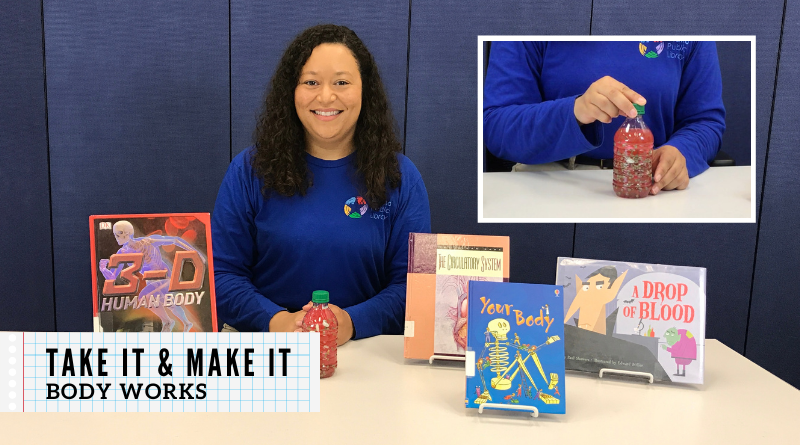
STEAM Connections: Body Works
If you’ve ever scraped your elbow or knee, chances are you’ve seen blood up close. But what exactly is blood? Where does it come from? And what does it do?
Content Overview
Blood acts like a train that carries oxygen and essential vitamins and minerals to locations in our body. Along with carrying good things to our organs, blood also carries carbon dioxide and waste that our bodies no longer need to our lungs, kidneys, and digestive system where it will be removed. Blood also helps us fight infections when we are not feeling well. As blood circulates through our body, it works to keep us warm, but to ensure areas like our brain don’t overheat, it also acts as a cooling mechanism.
Blood is made up of four components: plasma, red blood cells, white blood cells and platelets.
- Plasma is a yellow liquid that transports nutrients and proteins throughout our body and carries away waste made by the cells in our bodies. Even though it’s red, over half of blood is made of plasma.
- Red blood cells take oxygen around our bodies when we breathe in. They also carry carbon dioxide to our lungs, where it leaves our bodies.
- White blood cells are part of the germ-fighting immune system. They attack invaders like viruses or bacteria to keep our bodies helpful. There are several types of white blood cells and each type has its own role in attacking different kinds of germs.
- Platelets are the smallest component of blood. These tiny cells work like bandages. If a blood vessel is broken, like when you have a scrape or a cut, platelets stick to the break to stop the bleeding and fix the broken vessel.
Hands-On Exploration
We are going to take a closer look at the components of blood and how they work together by making a blood model.
Activity Demonstration and Supplies

You will need:
- 1 cup red water beads
- 1 tablespoon white beans
- 1/8 cup lentils or rice
- 8-ounce empty clear water bottle or clear cup
- Water
- Funnel
Instructions:
- Place your empty container on an even surface.
- Using a funnel, pour the red water beads into the container. These are your red blood cells.
- Using a funnel, pour the white beans into the container. These are your white blood cells.
- Using a funnel pour the lentils or rice into your container. These are your platelets.
- Carefully pour water into your container. This is your plasma.
- Gently stir your plasma, red blood cells, white blood cells and platelets together.
- Observe the four components of blood in your model!
Talk About the Activity
- What did you notice about the difference in the amount of each component?
- Do you remember the function of each component?
- What other materials can you use to create a larger or smaller blood model?
Check It Out
Learn more about blood and the with resources from the library:

A Drop of Blood by Paul Showers
The Bloody Book of Blood by Kelly Regan Barnhill
Pump It Up!: The Secrets of the Heart and Blood by Melissa Stewart
Your Circulatory System Works! by Flora Brett




